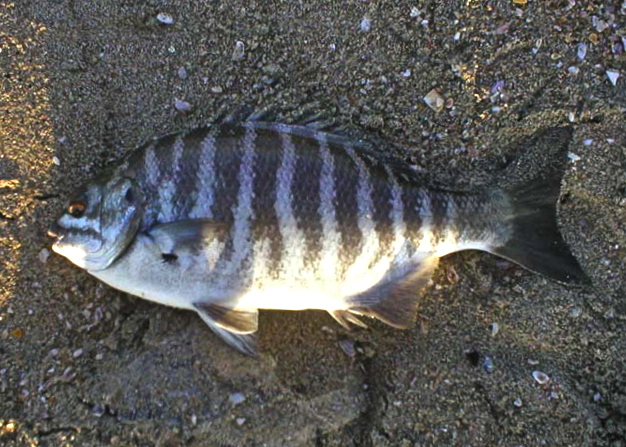Sea Chubs: Family Kyphosidae
Species: Hermosilla azure (Jenkins & Evermann, 1889); from Hermosillo (the name of the capitol city of Sonora Province in Mexico, near where first collected) and the Latin word azurea (sky-blue coloring).
Alternate Names: Zebra perch, convict fish and sea chub. In Mexico called chopa azul or chopa bonita.
Identification: An oval-shaped body with a bright blue spot on the gill cover, behind the eye. Usually dusky or olive-brown to black above but some specimens are greenish or silver-gray; whitish below. Zebras usually have about a dozen faint, azure-colored, vertical bars on the side.
Size: Length to 17.4 inches. Most caught from piers are fairly good size, 10-14 inches long. A 16-inch fish weighed 3 pounds 2 ounces.
Range: Gulf of California and along the Pacific Coast from Baja California, to the Klamath River estuary, northern California. Common from Baja California to southern California.
Habitat: Typically intertidal to 25 feet deep although recorded to 49 feet deep. Usually found around rocks or reefs in small schools, often mixed with opaleye and halfmoon.
Piers: Most common at piers near rocky areas. Best bets: Ocean Beach Pier, Oceanside Harbor Pier, San Clemente Pier, Huntington Beach Pier, Cabrillo Mole (Avalon), Paradise Cove Pier, Stearns Wharf, Goleta Pier and Gaviota Pier.
Shoreline: An infrequent but valued catch by rocky shore anglers in southern California.
Boats: Rarely taken by boaters.
Bait and Tackle: Light tackle with small hooks (size 8 or 6) and light line works best. Bait: moss is the best bait but fresh mussels, bloodworms and peas seem to catch a few fish.
Food Value: A fair eating fish that is mild flavored, small flaked, firm textured, and low in fat content but not considered as good as opaleye or halfmoon. It is suitable for many forms of cooking but most commonly fried.
Comments: Hard to catch because of their vegetarian diet and their shy and cautious nature. Studies done on zebraperch at Catalina showed them to be herbivores with a macroalgal diet. Stomach contents revealed algae, lots of it, with red algae (88.2%) being the predominate food. Brown algae (7.8%) and green algae (4.0%) also added to the mix but animal matter was less than .01%. Unfortunately, snaggers take most zebras. Zebraperch are in the same family of sea chubs as opaleye and halfmoon.

Do they ever show up in the surf in mid fall and early winter? It’s the only sea chub i haven’t caught so far. What baits do you recommend?
Hi Ken,
Do you think is possible to find Bermuda Chubs in South California?
I have been in Science Museum in San Francisco and they have a big one in their aquarium.
Thanks.
No, they’ve never been recorded in California.
Hello,
Thanks for your report on the’Zebraperch’. In my 50 years of surf fishing this was my first encounter with one. I accidently snagged a 14 inch fish off San Onofre
and released it.
May the FISH be with you ! ! !
Glad you enjoyed the report.
Zebra perch seems to start losing its black stripes when it’s dying.
Caught one in surf near so Carlsbad S/P today. Had never seen one before. Put up a good fight on 4# leader.